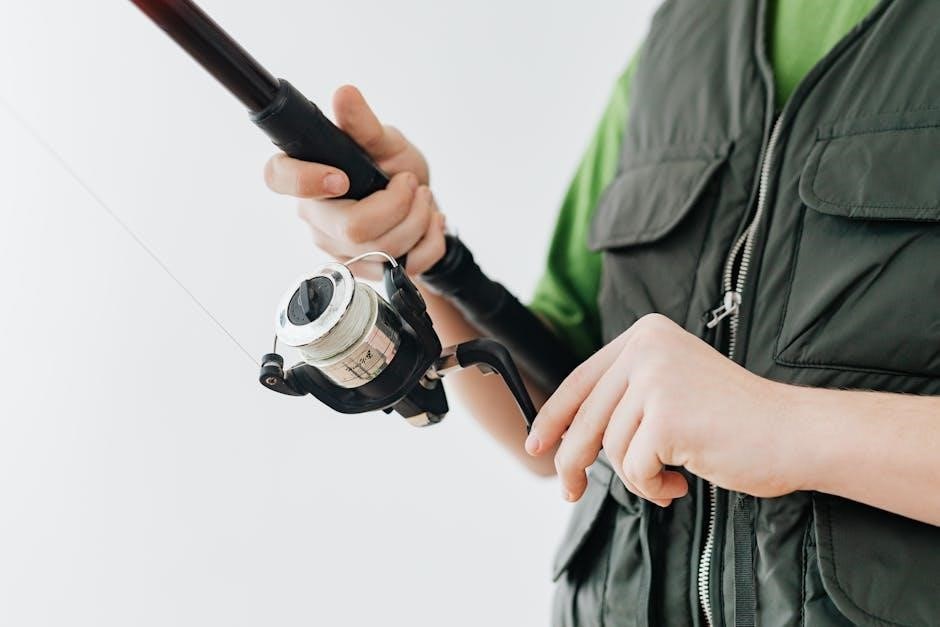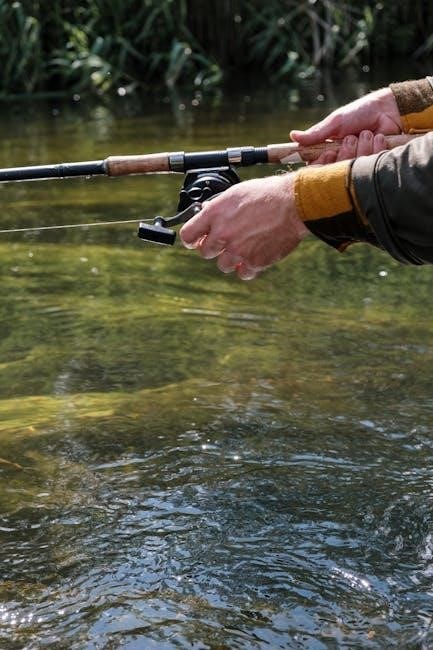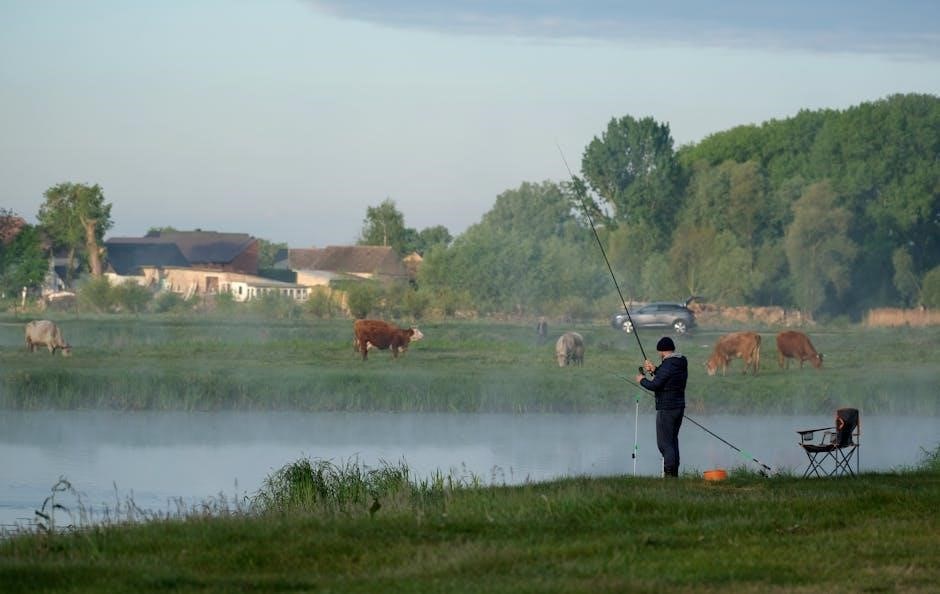Choosing the right fishing rod size is crucial for a successful angling experience. Rod length‚ action‚ and power ratings significantly impact casting distance and accuracy. This guide explores these key factors to help anglers select the perfect rod for their fishing needs‚ ensuring optimal performance across various fishing techniques and environments.
1.1 Importance of Choosing the Right Rod Size
Choosing the right rod size is essential for optimal fishing performance‚ comfort‚ and effectiveness. A rod that is too short or too long can hinder casting accuracy and distance‚ while an inappropriate action or power rating may fail to handle the target species or fishing conditions. Selecting a rod that balances line weight‚ lure size‚ and fishing technique ensures a more enjoyable and successful angling experience.
1.2 Overview of Key Factors in Rod Sizing
Key factors in rod sizing include length‚ action‚ power‚ and material. Length affects casting distance and leverage‚ while action determines flexibility and responsiveness. Power relates to line weight capacity and strength‚ influencing the rod’s ability to handle specific fish sizes. Material choices‚ such as graphite or fiberglass‚ impact durability and sensitivity. Understanding these elements ensures anglers select rods tailored to their fishing style‚ target species‚ and preferred techniques‚ enhancing overall performance and efficiency.
Understanding Rod Length and Its Impact
Rod length significantly influences casting distance‚ leverage‚ and control. Longer rods enhance casting range but may reduce maneuverability‚ while shorter rods offer precision and ease in tight spaces.
2;1 How Rod Length Affects Casting Distance
Rod length directly impacts casting distance. Longer rods generate more leverage and momentum‚ allowing for farther casts. Shorter rods‚ while less effective for distance‚ provide better accuracy and control in tight spaces. The optimal length balances casting range with maneuverability‚ depending on the fishing environment and technique. Anglers must consider their specific needs to maximize performance.
2.2 Ideal Rod Lengths for Different Fishing Techniques
Different fishing techniques require specific rod lengths for optimal performance. For surf fishing‚ rods between 9-10 feet are ideal for casting distance. Trolling often uses 7-9 foot rods for better control. Fly fishing typically employs 8-9 foot rods for precise casting‚ while ice fishing uses shorter 2-3 foot rods for tight spaces. Choosing the right length ensures effectiveness and ease of use in various fishing scenarios.
Action Types: Fast‚ Medium‚ and Slow
Action Types: Fast‚ Medium‚ and Slow. Fast action rods bend near the tip‚ offering sensitivity and quick hook sets. Medium action rods provide balanced flexibility‚ while slow action rods bend more‚ offering a smoother experience. Each type suits different fishing styles and preferences.
3;1 Differences Between Fast Action and Slow Action Rods
Fast action rods bend primarily near the tip‚ offering heightened sensitivity and quick hook-setting power‚ ideal for lure fishing. Slow action rods bend from the lower third‚ providing a smoother‚ more forgiving experience‚ often preferred for bait fishing. Fast action rods excel in precision and strength‚ while slow action rods offer better control for lighter lines and smaller fish‚ catering to different fishing styles and preferences.
3.2 Selecting the Right Action for Your Fishing Style
Anglers should choose rod action based on their fishing technique and target species. Fast action rods are ideal for casting lures and setting hooks quickly‚ offering precision and strength. Slow action rods are better for bait fishing‚ providing a more forgiving feel and better control for lighter lines. Matching the rod action to your fishing style ensures optimal performance and a more enjoyable experience on the water.

Power Ratings and Line Weight Recommendations
Power ratings guide line weight selection‚ ensuring rods handle specific fishing conditions effectively. Matching line weight to rod power enhances casting performance and fish-handling capabilities.
4.1 Understanding Line Weight and Rod Power
Line weight and rod power are closely linked‚ with rod power indicating the strength and line weight capacity. A rod rated for 15-30lb line can handle fish up to 30lb. Proper matching ensures optimal performance‚ preventing rod breakage and improving casting accuracy.
4.2 Matching Lure Weight to Rod Specifications
Matching lure weight to rod specifications ensures optimal performance. Lighter lures work best with lighter rods‚ while heavier lures require sturdier rods. Proper balance enhances casting accuracy and fish-fighting capability. Using lures that exceed the rod’s recommended weight can lead to poor casting performance or rod damage. Always check the manufacturer’s guidelines to pair lures appropriately‚ maximizing efficiency and enjoyment in your fishing experience.

Selecting the Right Rod for Freshwater Fishing
Freshwater fishing requires rods tailored to target species‚ techniques‚ and water conditions. Versatile rods for trout‚ bass‚ and panfish ensure effective performance in diverse fishing scenarios.
5.1 Rod Sizes for Trout‚ Bass‚ and Panfish
For trout‚ a 5-foot rod is ideal for precision casting‚ while bass fishing often uses 6-7 foot rods for longer casts and heavier lures. Panfish angling typically requires shorter‚ lighter rods (4-6 feet) to handle small hooks and lines effectively. These lengths ensure proper balance‚ control‚ and performance when targeting specific species in freshwater environments.
5.2 Considerations for Stillwater vs. River Fishing
Stillwater fishing often requires shorter rods (5-6 feet) for precise control in tighter spaces‚ while river fishing benefits from longer rods (7-9 feet) to manage strong currents and longer casts. Material choice also varies: graphite rods excel in stillwater for sensitivity‚ while fiberglass or composite rods are more durable for river conditions. Understanding these differences ensures optimal performance in each environment.
Saltwater Fishing Rod Size Considerations
Saltwater fishing rods vary in length and strength based on the species and fishing location. Longer rods (8-12 feet) are ideal for surf fishing‚ while shorter rods (6-8 feet) suit offshore fishing.
6.1 Rod Lengths for Surf Fishing and Offshore Fishing
Surf fishing typically requires rods between 8-12 feet‚ allowing for longer casts to reach fish in the surf zone. Offshore fishing uses shorter rods (6-8 feet)‚ optimizing accuracy and leverage when battling larger species in deeper waters. Proper rod length ensures effective casting and handling in these challenging environments‚ enhancing overall fishing success and angler experience.
6.2 Recommended Sizes for Targeting Specific Species
Targeting specific species demands tailored rod sizes. For striped bass and bluefish‚ 9-10 foot rods are ideal‚ while smaller species like trout may require shorter lengths. Larger pelagic species‚ such as tuna or marlin‚ often necessitate heavy-duty offshore rods (6-9 feet) for strength and control. Matching rod size to species ensures effective hook-setting and fish handling‚ maximizing success in both surf and offshore environments.

Fly Fishing Rod Size Guide
Fly rods range from 1-weight for small trout in tiny streams to 14-weight for large game fish‚ offering versatility for diverse fishing conditions and species.
7.1 Weight Ratings for Fly Rods
Fly rods are rated by weight‚ with 1-weight rods for small trout and 14-weight for large game fish. The weight indicates the rod’s strength and line capacity‚ ensuring proper balance and performance. Lighter weights (1-4) handle small fish‚ while heavier weights (10+) tackle large species. Matching the rod’s weight to the target species and fishing conditions is essential for optimal casting and fighting ability.
7.2 Choosing the Right Fly Rod for Different Waters
When selecting a fly rod‚ consider the water type and target species. For stillwaters‚ a 5-weight rod is versatile‚ handling small to medium fish effectively. In rivers‚ shorter rods (8-9 feet) excel in tight spaces‚ while longer rods (10+ feet) improve line control in open waters. Species-specific recommendations‚ like a 9-weight for stripers or a 4-weight for trout‚ ensure optimal performance. Match rod length and action to water conditions for precise casting and better hook sets.
Understanding Rod Material and Construction
Fishing rods are made from graphite‚ fiberglass‚ or composite materials‚ each offering unique benefits. Graphite rods are lightweight and sensitive‚ while fiberglass rods are durable and flexible.
8.1 Graphite vs. Fiberglass vs. Composite Rods
Graphite rods are lightweight and sensitive‚ ideal for detecting bites and casting accuracy. Fiberglass rods are durable and flexible‚ perfect for heavy-duty fishing. Composite rods combine both materials‚ offering a balance of strength and sensitivity. Each material caters to different fishing styles and environments‚ making it essential to choose based on specific needs and preferences for optimal performance on the water.
8.2 How Material Affects Rod Performance
Material significantly impacts a rod’s sensitivity‚ durability‚ and flexibility. Graphite rods offer exceptional sensitivity and lightweight feel‚ making them ideal for detecting bites. Fiberglass rods are more durable and flexible‚ suitable for heavy-duty fishing. Composite rods blend these traits‚ providing a balance of strength and sensitivity. The choice of material directly influences the rod’s performance‚ catering to specific fishing styles‚ techniques‚ and environmental conditions‚ ensuring anglers can optimize their gear for success.

Tips for Testing a Rod Before Purchase
Always test a rod’s weight‚ balance‚ and action. Check sensitivity and flexibility by bending it gently. Ensure it feels comfortable and responsive for your fishing style.
9.1 What to Look for in a Rod’s Performance
When testing a rod‚ assess its sensitivity‚ action‚ and weight distribution. Ensure it offers a smooth casting experience and good balance. Check for responsiveness and durability. Look for consistent performance across different fishing conditions and techniques. A well-performing rod should feel comfortable and deliver accurate casts‚ making it suitable for your specific fishing style and target species. Practical testing helps confirm these qualities.
9.2 Practical Testing Techniques
Test a rod by casting with different lures or weights to assess its performance. Check for sensitivity by lightly pressing the tip. Ensure the rod feels balanced and comfortable in hand. Simulate real fishing conditions to evaluate responsiveness and durability. Pay attention to how smoothly it casts and handles varying loads. Practical testing helps identify the rod’s strengths and suitability for your fishing style and target species.
This guide provides a comprehensive overview of fishing rod sizing to enhance your angling experience. Select a rod that suits your style‚ target species‚ and environment for optimal results.
10.1 Recap of Key Considerations
When selecting a fishing rod‚ consider length‚ action‚ and power ratings to match your fishing style and target species. Rod length impacts casting distance‚ while action affects sensitivity and strength. Pairing the right line weight and lure size ensures optimal performance. Material choices‚ such as graphite or fiberglass‚ influence durability and responsiveness. By aligning these factors with your fishing environment‚ you can enhance your overall angling experience and success.
10.2 Final Tips for Selecting the Perfect Rod
To select the perfect rod‚ start by determining your fishing style and target species. Balance rod length‚ action‚ and power ratings for your specific needs. Consider the fishing environment‚ as freshwater and saltwater requirements differ. Prioritize rod material‚ such as graphite for sensitivity or fiberglass for durability. Test the rod before purchasing to ensure comfort and performance. Finally‚ stay within your budget while investing in quality to enjoy a rewarding fishing experience.